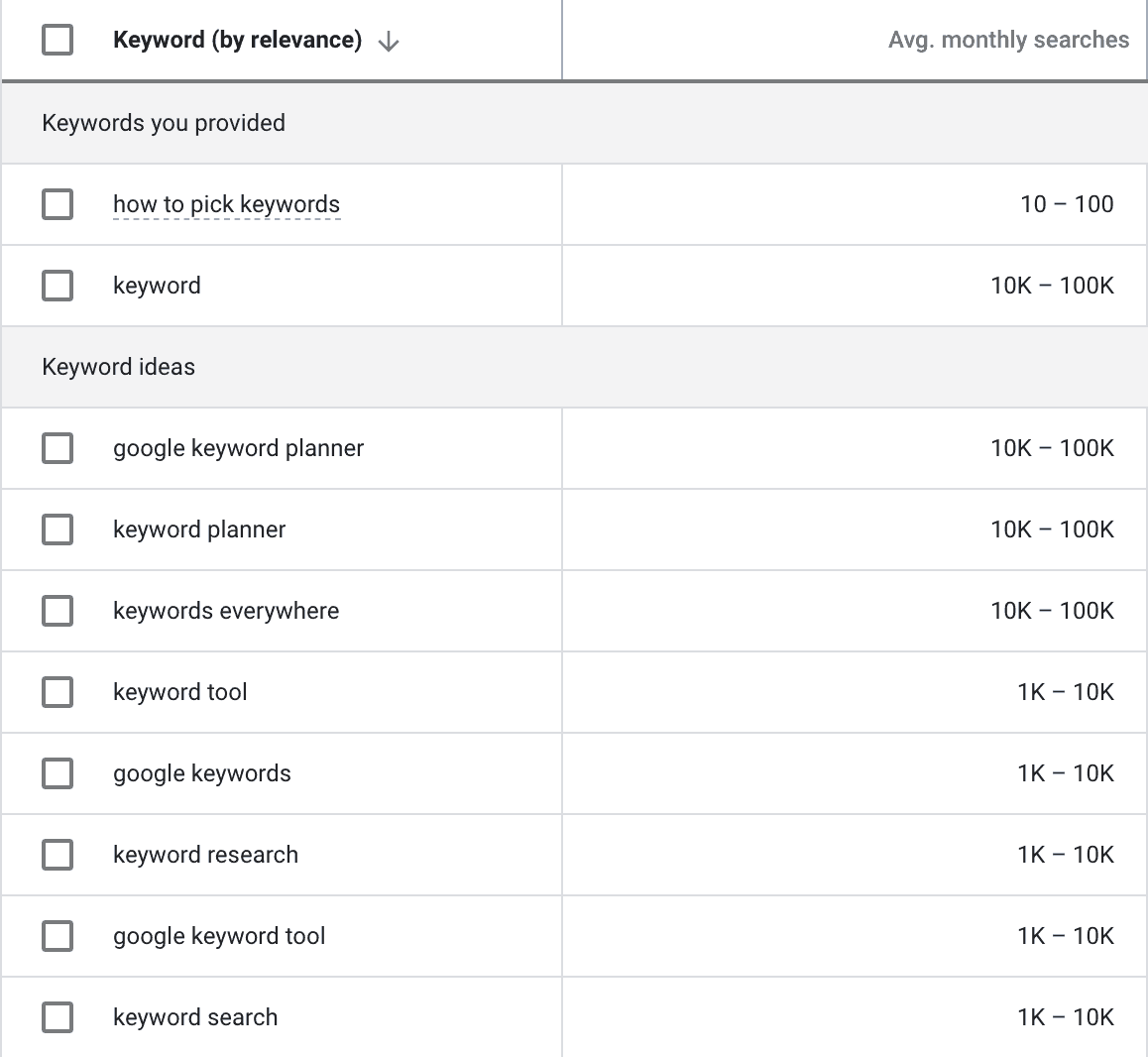Keyword Research: Trust the Process (and the Right Tools) For SEO Success


In this week’s installment of Mediavine’s SEO series, we’re taking our ongoing discussion of keywords to a whole new level.
We began at the start, with the basics of what is a keyword — a more complicated question than many people might think.
From there we delved into long tail keywords and cornerstone content, the two types of keywords we are most focused on.
Armed with that knowledge, now’s the time to really get down to business with keyword research, or keyword planning.
How do you actually, you know, pick the keywords?
Before we answer that, the first step is to make sure we’re on the same page when we talk about what keyword research is.

We’re talking about the process of selecting the keyword your post will target, or what your focus keyword for that post will be.
If you find that multiple keywords could describe a particular post, that’s great, but with our strategy, you’re going to pick one.
We like to focus on one keyword per post. Definitely make note of the other keywords and add them to your content schedule — writing lots of related content is also an important component of our strategy — which we’ll get to in a bit.
For now: Focus in on one keyword, or key phrase, per post.

The first step is honing in on what you want to write about. What would a user type into a search engine to try and find this content?
If you’re writing a recipe for something popular, odds are there’s a universal, or at least fairly common name for what you’re making.
By contrast, if you’re making something original and aren’t sure what to call it, you may want to be less creative than you think.
Either way, people are searching for it. Whatever the topic is, put yourself in the shoes of would-be readers — the ones researching it.
The key here is to be as generic as you can, because you’re about to receive a crucial boost from someone who knows Google the best:
Google itself.
Once you narrow down the most generic words that a reader might use to search for your content, you’ll be ready to pick your keyword.
A keyword planning tool is essential to doing keyword research, and fortunately, there are free keyword planning tools.
Better yet, they’re actually all by Google.
The catch? None of these tools are going to give you the exact numbers you’re after, but they’re helpful nonetheless.
Let’s break down the most popular:
This is the most official keyword tool from Google, and no one will ever accuse Keyword Planner of not living up to its keyword-rich name.
It’s a tool designed for people purchasing Google AdWords, particularly for buying ads that appear in Google Search results.
You’ll need to sign up for a Google Ads account, but don’t worry — you won’t need to actually buy ads to use this keyword tool.
As you type in generic terms, Keyword Planner will offer keyword suggestions, with data such as approximate monthly searches.
Warning: The data provided will likely be broad and inexact, but it should give you a strong starting point and, well, it’s free.
There are some other Google tools you can use to find additional keywords, such as “People Also Ask” and “Related Searches,” which you will find in Google search results.
We’ll come back to those when we dive into our related content strategies, because they’ll be much more useful within that context.
For raw — and free — keyword planning, use Google Keyword Planner. If more and stronger data is what you want, you’re going to have to pay.

We’ll have more on these in future blog posts, but three popular options publishers use are SEMrush, Ahrefs and Keysearch.
I personally use SEMrush, but all three of these are powered by very similar datasets pulled from the same search engines.
Their results should be fairly similar, so it becomes a matter of personally weighing the costs and different tools they provide.
I’m a fan of lots of the other features of SEMrush, which is ultimately why I went that route, but it’s a matter of preference.
More to come on paid options down the line. For now, what matters is that you’re utilizing any keyword planning tool. Onward!
Hopefully after trying out a few generic terms to describe your post, you’ll get a feel for what users have been searching for.
What’s important is utilizing the related keyword and broad search features to make sure you’re headed down the right path.
To illustrate, let’s use the post you’re reading right now.
Very meta, I know. So as I sat down to write this post, my first thought might’ve been to title it: “How to pick a keyword?”
Or not. If I typed “How to pick a keyword” into Google Keyword Planner, I’d end up with a small volume of search (10-100).
Fortunately, Google offered to help me broaden with the term “keyword,” so I added that to the mix. Game changer.
All of a sudden, I’m looking at a lot of keywords that still describe my post, but with far more monthly search volume:

Your mind may immediately gravitate toward the results with the most searches, but think back to our long tail keyword post.
The key is to find the right balance by weighing these factors:
In this case, you may think wow, “Keyword Planner” has great volume (10-100k) and accurately describes my blog post.
Spoiler: If you’re reading this, you know I didn’t choose that. Why did I skip on down to Keyword Research (1-10k)?
Because raw volume doesn’t tell the whole story, particularly when thinking about this through the lens of user intent.
Moreover, the third bullet point above — a very simple competitive analysis — steered me toward “Keyword Research.”
Do a Google search for “Keyword Planner.”
(NOTE: Make sure you search via Private Browsing mode, or Incognito in Chrome, so Google shows you what the general population sees instead of personalized results based on your own browsing history.)
You’ll find all the top search engine results are for keyword planning tools, with Google’s own Keyword Planner at the top.
Google nailed the user intent of these queries — people looking for actual keyword planning tools, not my blog post. (Rude.)
Since the Mediavine roadmap doesn’t include offering a keyword planning tool with this article (or any time soon), I ceded that term and moved on.
“Keyword Research” is next in line, still with fairly significant volume. Let’s head back to Google to see the results there.
The first three organic results are all articles about how to do keyword research and use keyword planning tools.
Wow, I can do that, I thought. Good job, me.
So now I’ve got a keyword that fits the user intent and meets the criteria of reasonable traffic volume. But it’s not over yet.

Okay, let’s head back to Google, still in Incognito mode, to search for “keyword research.” This time we’re looking at the results a bit differently:
Who ranks in the top 10 for this search term?
It looks like Moz, Yoast and Neil Patel, the usual suspects in the world of SEO blogging. What you’re looking for in this or any example are websites similar to your own that are ranking highly.
What does “similar” mean in this context?
In general terms, it’s sites with a comparable format, PageRank, level of expertise, etc. If you consider these sites your “peer set,” typically writing about and ranking on similar topics, you’re on the right track.
You can also use the total number of search results (as shown by Google) to gauge how much competition is out there. (This won’t necessarily indicate the quality of the competition, so I typically stick to the top 10).
Note that this process is more of a gut check, so to speak, than an official checklist. Many of the aforementioned factors aren’t things you can easily look up about other websites with certainty.
With that said, in our example those blogs are formatted and producing content in line with the Mediavine SEO strategy, and we feel they’re likely similar in PageRank as well.
In other words, I’m not scared. The usual suspects are great resources, but I believe Mediavine has a lot to offer along with them, and can compete in this particular space.
You know who would scare me in the SEO blogging world? Google. Remember them? The little company that dominated spots 1-3 for Keyword Planning? Hard pass.
When doing your own competitive analysis, consider this factor: Are household names and legacy brands dominating the top 10, or are those spots held by bloggers and independent content creators like you?
Those of you who have used keyword planning tools in the past have probably noticed a “competition” column there.
Do NOT use this.
All of these tools are getting their data from paid search, and they’re showing you competition for buying keywords.
Paid and organic search results are completely different things, and the competition for them is unrelated. Ignore.
Yes, but often times in your keyword research, you’re going to find there are more terms than you’re writing about.
Stock those away in your long term content strategy. In future posts, we’ll be talking a lot more about content strategy and how to make use of these other related posts to boost search results.
For now, though, yes. It may seem like a lot of effort, but it’s worth it. Remember above? If we didn’t put in the work and trust the process, we might have squandered the ranking potential of this very post.
Besides, conceptualizing and creating the blog post itself will require the bulk of your energy. Look at keyword research as the final step to ensure that hard work doesn’t go unnoticed — by Google and your readers.
Next up we will be covering keyword prominence and stop words. Don’t miss our big list of SEO Resources if you’d like to learn more.
Stay up to date with the latest from Mediavine
 Eric Hochberger
Eric Hochberger
Google recently announced that any publisher passing the new Page Experience algorithm will be considered for the top story carousels in Google News. This shift comes after years of Google …
 Eric Hochberger
Eric Hochberger
Whether it’s for SEO or monetization purposes, we always encourage publishers to update old content. We’ve discussed at length how specifically to update content to improve RPM and optimize for …
 Eric Hochberger
Eric Hochberger
Today on the Mediavine blog, we’re throwing it back to 2017, famously known to SEO experts across the web as the Year of the Parboil. It was never actually known …